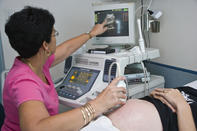Centre of a Person's Universe
The brain’s slow passage into consciousness starts just days after conception: the newly fertilised egg travels down the woman’s Fallopian tube; while it is heading for the uterus, it is already a ballooning cluster of dividing cells.

These will bed themselves down in the wall of the uterus and, within three weeks of conception, the first layers of cells are lining themselves up to become the heart, skin, nervous system, bones, intestines, kidneys and bladder. By four weeks, minuscule stubs begin sprouting from the torso like flippers – these will later grow into arms and legs – and the first eye cells are swelling into black pinpricks.
At the same time, probably before the mother-to-be even knows she is pregnant, the first filaments of a brain and spine are curving themselves into the shape of a single quotation mark inside the bean-sized embryo. Round about now, moored to the wall of the mother’s womb, a heart begins to beat.
It is a rudimentary heart, little more than a pulsating tube, but its first thumps begin the pounding rhythm of an organ that will feed oxygen and nutrients to the body’s command hub, the cerebral tissue, for the rest of this person’s life. And that is where it all happens: where thoughts are lived, memories banked, images stored, concepts imagined, dreams dreamed, love felt.
This fragile tissue inside the skull is where anger will rage, where a stubbed toe will smart, where films will be watched and the unfolding tale of a novel processed. It is where a slammed door jolts the body to flight or the memory of a hit of nicotine will drive the hand to reach for another cigarette. It is here, in the brain, where the centre of this person’s universe will be for as long as the body stays oxygenated and alive.
Neurons Laid Down
During that first trimester, there is an explosion of growth in the brain, with hundreds of thousands of new brain cells – neurons – added every minute, clustering together into two distinctive hemispheres around a branching tree of veins that will keep feeding the brain’s voracious appetite for glucose throughout the person’s life.
The basic masonry for the human brain is laid down by the time the foetus reaches six months, and in the third trimester the smooth-edged brain begins to buckle and fold into the undulated surface of the mature brain. It is not just the bricklaying that is happening in the brain in utero, but also the mechanism for how well it works – the pathways along which the neurons talk to one another are forming now.
Once the child is born, when the mechanical and chemical processes have put the fabric of the brain in place, stimulation then becomes critical. Impulses from the outside world force stronger connections between the neurons, helping the child to become more mentally agile.
By the time the baby takes its first breath, most of the neurons it will need for the rest of its life (other than the regenerating ones in the hippocampus) will be there, ready and waiting. The brain will keep on laying down its neurons, brick by steady brick for the next few months, so that by the age of two, the brain is about 80% of its adult size.
First Dibs on Nutrients
A baby in utero is often described as a parasite, having first dibs on all the nutrients cycling through the woman’s blood. But it is not enough just to get calories that are loaded up with all the macronutrients – the fat, protein and carbohydrates. There also needs to be plenty of micronutrients for the foetus to strip from the circulating blood, too.
Without these nutrients present in the mix at the time when the basic masonry work is being done on the brain, the result can be a brain that operates subpar, not just during the period of time when the nutrition deficiency occurs, but for the rest of that person’s life.
There is a mountain of evidence to support the fact that nutrition-related underdevelopment in the young central nervous system in the first 24 months of a child’s life is linked to underperformance in school and a decreased IQ later in life.